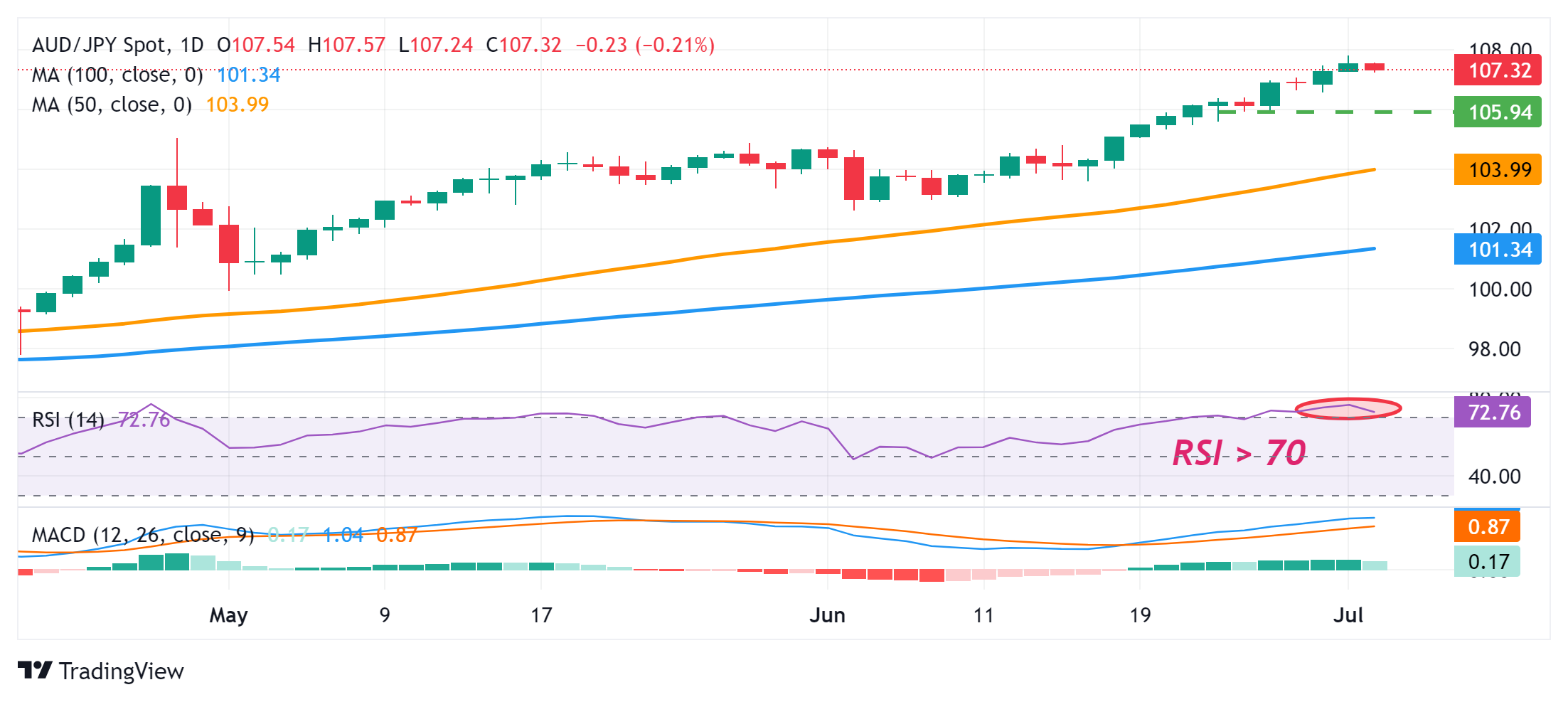AUD/JPY Price Analysis: Corrects from multi-year peak, downside potential seems limited
- AUD/JPY pulls back from its highest level since 2007 touched on Monday.
- The less hawkish RBA minutes prompts bulls to take profits off the table.
- The technical setup makes it prudent to wait for a near-term consolidation.
The AUD/JPY cross drifts lower during the Asian session on Tuesday and moves away from its highest level since 2007, around the 107.80-107.85 region touched the previous day. Spot prices currently trade around the 107.25 region, though any meaningful corrective decline still seems elusive.
The Australian Dollar (AUD) is pressured by the less hawkish Reserve Bank of Australia (RBA) meeting minutes, which pointed to the risk of a sharp slowdown in the labour market. Apart from this, China's economic woes further undermine the China-proxy Aussie and exert downward pressure on the AUD/JPY cross. Meanwhile, the Bank of Japan (BoJ), so far, has failed to provide any cues about the timing of the next rate increase, which continues to weigh on the Japanese Yen (JPY) and should lend some support to spot prices.
From a technical perspective, the intraday downtick could be solely attributed to some profit-taking amid extremely overbought oscillators on the daily chart. Any subsequent decline, however, is likely to find decent support and attract fresh buyers near the 107.00 round-figure mark. This, in turn, could limit the downside for the AUD/JPY cross near the 106.60 support, which now seems to act as a pivotal point. A convincing break below the latter might prompt some long-unwinding trade and drag spot prices to the 106.00 mark.
On the flip side, the 107.80-107.85 region, or the multi-year peak touched on Monday, now seems to act as an immediate hurdle ahead of the 108.00 mark. Some follow-through buying will be seen as a fresh trigger for bullish traders and pave the way for an extension of the recent strong move-up witnessed over the past two months or so. That said, the technical setup makes it prudent to wait for some near-term consolidation or some meaningful corrective decline before positioning for any further near-term appreciating move.

RBA FAQs
The Reserve Bank of Australia (RBA) sets interest rates and manages monetary policy for Australia. Decisions are made by a board of governors at 11 meetings a year and ad hoc emergency meetings as required. The RBA’s primary mandate is to maintain price stability, which means an inflation rate of 2-3%, but also “..to contribute to the stability of the currency, full employment, and the economic prosperity and welfare of the Australian people.” Its main tool for achieving this is by raising or lowering interest rates. Relatively high interest rates will strengthen the Australian Dollar (AUD) and vice versa. Other RBA tools include quantitative easing and tightening.
While inflation had always traditionally been thought of as a negative factor for currencies since it lowers the value of money in general, the opposite has actually been the case in modern times with the relaxation of cross-border capital controls. Moderately higher inflation now tends to lead central banks to put up their interest rates, which in turn has the effect of attracting more capital inflows from global investors seeking a lucrative place to keep their money. This increases demand for the local currency, which in the case of Australia is the Aussie Dollar.
Macroeconomic data gauges the health of an economy and can have an impact on the value of its currency. Investors prefer to invest their capital in economies that are safe and growing rather than precarious and shrinking. Greater capital inflows increase the aggregate demand and value of the domestic currency. Classic indicators, such as GDP, Manufacturing and Services PMIs, employment, and consumer sentiment surveys can influence AUD. A strong economy may encourage the Reserve Bank of Australia to put up interest rates, also supporting AUD.
Quantitative Easing (QE) is a tool used in extreme situations when lowering interest rates is not enough to restore the flow of credit in the economy. QE is the process by which the Reserve Bank of Australia (RBA) prints Australian Dollars (AUD) for the purpose of buying assets – usually government or corporate bonds – from financial institutions, thereby providing them with much-needed liquidity. QE usually results in a weaker AUD.
Quantitative tightening (QT) is the reverse of QE. It is undertaken after QE when an economic recovery is underway and inflation starts rising. Whilst in QE the Reserve Bank of Australia (RBA) purchases government and corporate bonds from financial institutions to provide them with liquidity, in QT the RBA stops buying more assets, and stops reinvesting the principal maturing on the bonds it already holds. It would be positive (or bullish) for the Australian Dollar.

